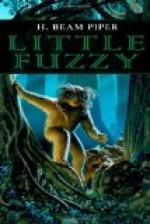“The sapient mind not only thinks consciously by habit, but it thinks in connected sequence. It associates one thing with another. It reasons logically, and forms conclusions, and uses those conclusions as premises from which to arrive at further conclusions. It groups associations together, and generalizes. Here we pass completely beyond any comparison with nonsapience. This is not merely more consciousness, or more thinking; it is thinking of a radically different kind. The nonsapient mind deals exclusively with crude sensory material. The sapient mind translates sense impressions into ideas, and then forms ideas of ideas, in ascending orders of abstraction, almost without limit.
“This, finally, brings us to one of the recognized overt manifestations of sapience. The sapient being is a symbol user. The nonsapient being cannot symbolize, because the nonsapient mind is incapable of concepts beyond mere sense images.”
Ybarra drank some water, and twisted the dial of his reading screen with the other hand.
“The sapient being,” he continued, “can do one other thing. It is a combination of the three abilities already enumerated, but combining them creates something much greater than the mere sum of the parts. The sapient being can imagine. He can conceive of something which has no existence whatever in the sense-available world of reality, and then he can work and plan toward making it a part of reality. He can not only imagine, but he can also create.”
He paused for a moment. “This is our definition of sapience. When we encounter any being whose mentation includes these characteristics, we may know him for a sapient brother. It is the considered opinion of all of us that the beings called Fuzzies are such beings.”
Jack hugged the small sapient one on his lap, and Little Fuzzy looked up and murmured, “He-inta?”
“You’re in, kid,” he whispered. “You just joined the people.”
Ybarra was saying, “They think consciously and continuously. We know that by instrumental analysis of their electroencephalographic patterns, which compare closely to those of an intelligent human child of ten. They think in connected sequence; I invite consideration of all the different logical steps involved in the invention, designing and making of their prawn-killing weapons, and in the development of tools with which to make them. We have abundant evidence of their ability to think beyond present sense data, to associate, to generalize, to abstract and to symbolize.
“And above all, they can imagine, not only a new implement, but a new way of life. We see this in the first human contact with the race which, I submit, should be designated as Fuzzy sapiens. Little Fuzzy found a strange and wonderful place in the forest, a place unlike anything he had ever seen, in which lived a powerful being. He imagined himself living in this place, enjoying the friendship and protection of this mysterious being. So he slipped inside, made friends with Jack Holloway and lived with him. And then he imagined his family sharing this precious comfort and companionship with him, and he went and found them and brought them back with him. Like so many other sapient beings, Little Fuzzy had a beautiful dream; like a fortunate few, he made it real.”




